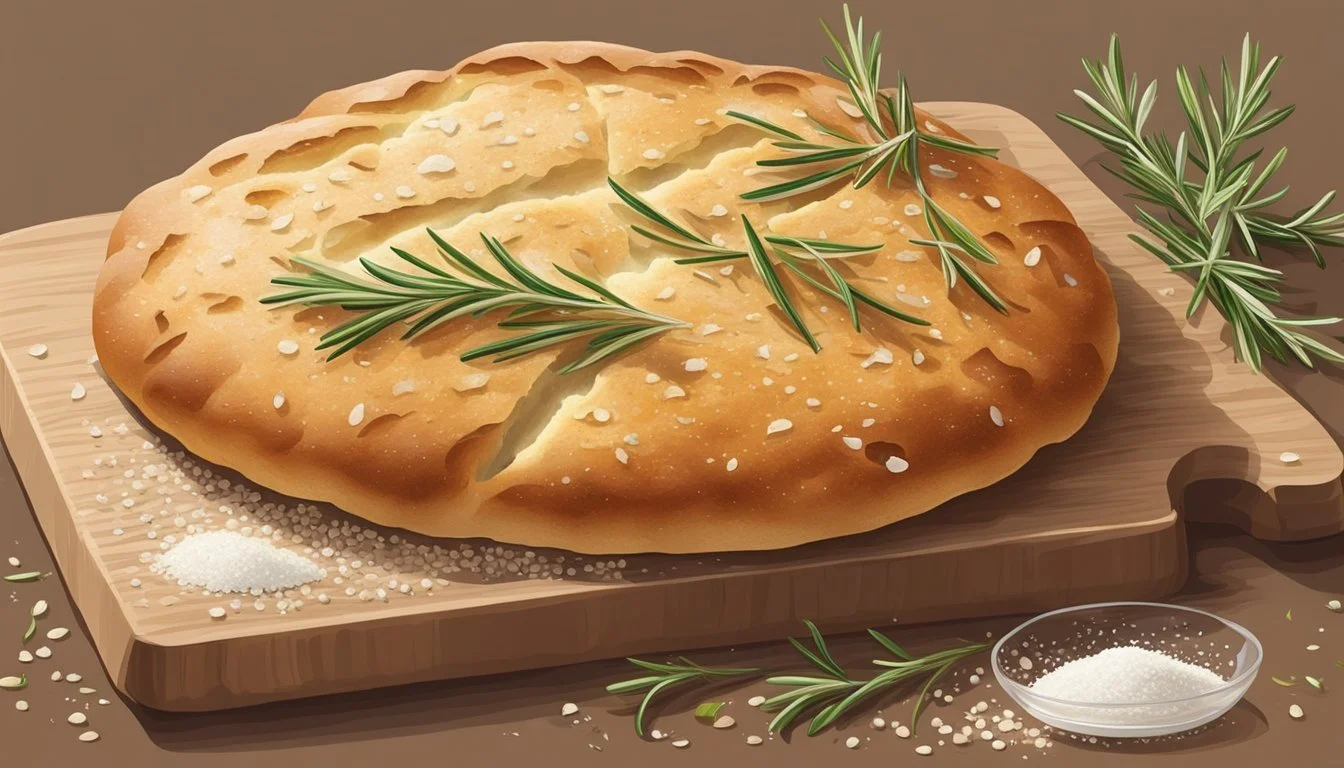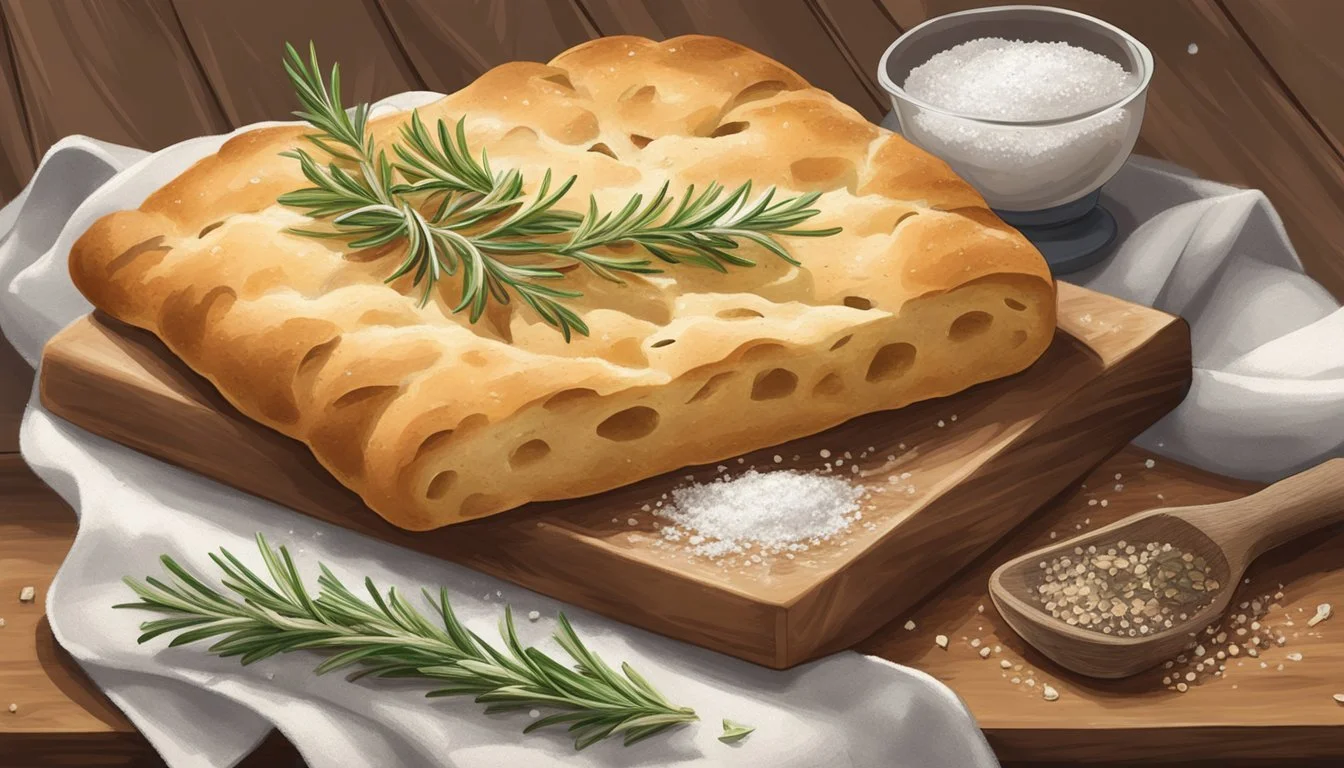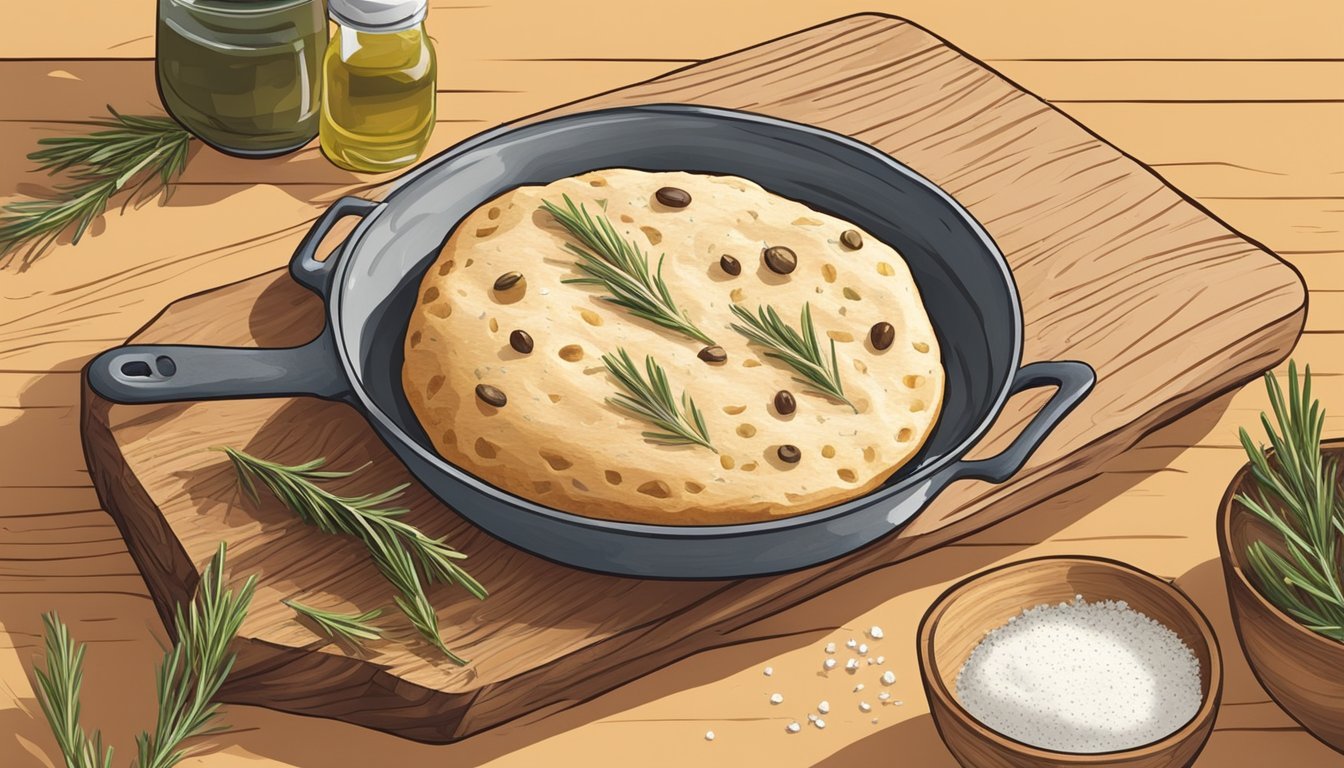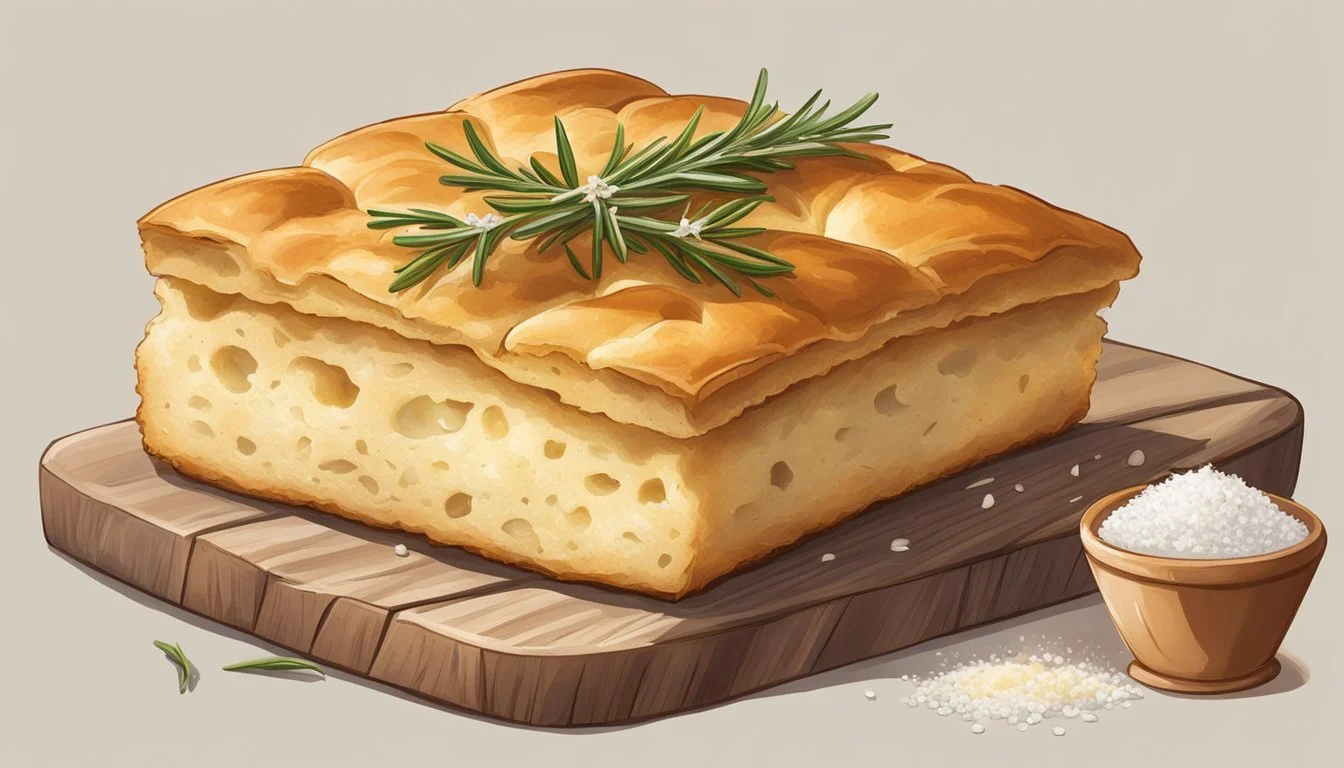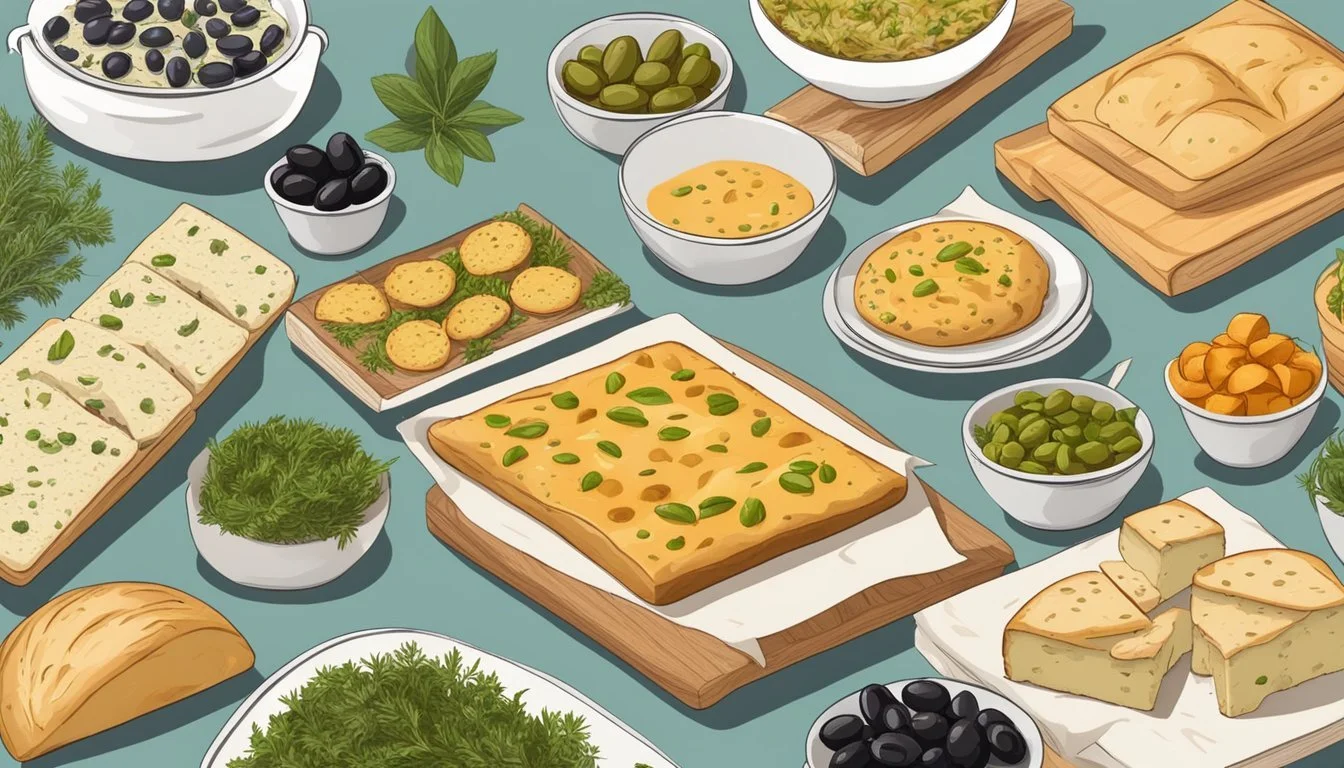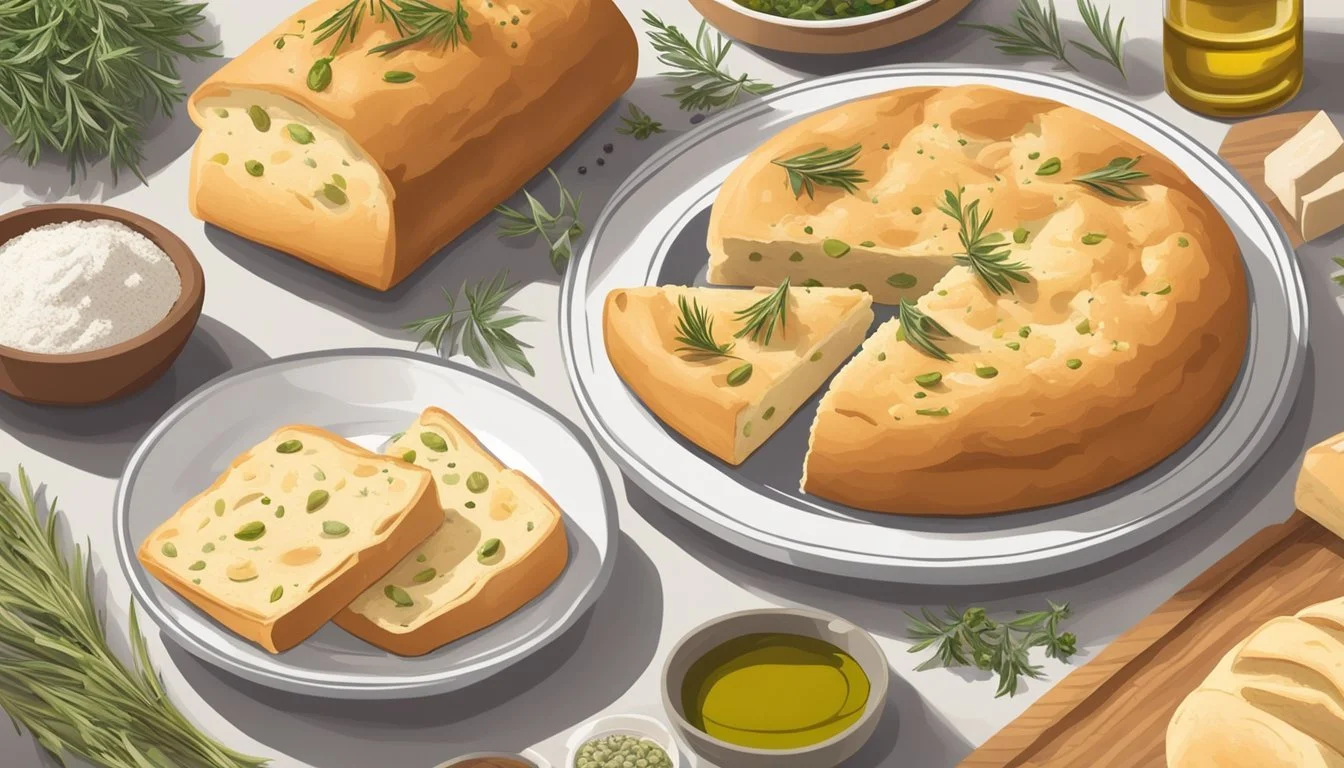Is Focaccia Gluten-Free?
Understanding Its Ingredients and Alternatives
Focaccia, a beloved Italian bread (What wine goes well with bread?), is traditionally made with wheat flour, which contains gluten. Gluten, a group of proteins found in wheat, barley, and rye, provides elasticity and structure to dough, making it essential for the airy and chewy texture of classic focaccia. This bread often consists of a crisp exterior and a soft, airy interior marked by dimples that are filled with olive oil and sometimes topped with herbs like rosemary, as well as other seasonings.
However, for those with celiac disease or gluten sensitivity, consuming gluten can lead to health issues, making traditional focaccia off-limits. The increasing demand for gluten-free options has led to the development of variations that substitute wheat flour with gluten-free alternatives. These recipes adapt the principal elements of focaccia while ensuring that the bread is safe for individuals following a gluten-free diet.
Gluten-free focaccia recipes typically employ a blend of gluten-free flours, such as rice flour, almond flour, or commercially prepared gluten-free all-purpose flours. Additionally, xanthan gum or baking powder may be included to replicate the binding and leavening effects that gluten traditionally provides. The resulting bread allows for an inclusive approach to enjoying focaccia without the presence of gluten, making it accessible for a wider audience while still delivering a delightful taste and texture similar to its traditional counterpart.
Defining Focaccia
Focaccia is a traditional Italian bread that has gained popularity across the globe for its rich flavor and versatility. Originating in ancient Rome, it is known for its characteristic dimples on the surface, which are created by pressing fingers into the dough before baking. Focaccia is typically seasoned with olive oil and can include additional toppings like herbs, olives, and sometimes vegetables.
The classic version of this bread has a crisp exterior and a soft, chewy interior, which comes from a high hydration dough. This moisture in the dough, combined with olive oil, results in a bread that is both tender and flavorful.
Bread Characteristics:
Texture: Crusty outside with a soft, airy inside.
Flavorings: Olive oil, salt, herbs (like rosemary), and other seasonings.
Shape: Usually flat and relatively thick, about 1 to 1 1/2 inches.
Although traditionally made with wheat flour, focaccia is a versatile bread that can also be prepared using gluten-free alternatives. These alternatives create the opportunity for those adhering to a gluten-free diet to enjoy focaccia. When made gluten-free, adjustments are necessary to mimic the texture and rise of wheat-based focaccia using ingredients such as gluten-free flour blends, xanthan gum, and baking powder.
It should be noted that not all focaccia is gluten-free. The standard recipe contains gluten, but various adaptations of the recipe can produce a gluten-free variant suitable for those with dietary restrictions.
Is Focaccia Bread Gluten-Free?
Traditional focaccia bread is not gluten-free. Focaccia, an Italian flatbread, is typically made with wheat flour, which contains gluten, a protein that gives bread its structure but can trigger health issues for people with celiac disease or gluten sensitivity.
For those requiring or preferring a gluten-free diet, gluten-free focaccia options are available. Gluten-free focaccia is crafted using alternative flour blends that do not contain gluten. These can include a mix of:
Potato starch
Tapioca starch
Almond flour
Corn flour
The gluten-free version requires different preparation methods to simulate the texture and taste of traditional focaccia. For instance, ingredients like xanthan gum, psyllium husk, or gluten-free baking powder are used to help the bread rise and maintain a proper structure.
Making gluten-free focaccia involves several steps:
Combining dry ingredients: Such as gluten-free flour blend, baking powder, and salt.
Wet ingredients: Mixing liquids like water and oil, sometimes gelatinized with psyllium husk or other binders.
Rising periods: The dough usually requires one or more rising times to develop air pockets and a soft texture.
It's important to note that while gluten-free breads mimic the characteristics of wheat-based breads, texture and flavor differences are often present. Additionally, one must ensure that all ingredients and kitchen tools used are free from gluten contamination to truly keep the focaccia gluten-free.
Key Ingredients for Gluten-Free Focaccia
The success of gluten-free focaccia hinges on the careful selection and combination of ingredients tailored to compensate for the absence of gluten. Attention to detail with flour blends, binders like xanthan gum or psyllium husk, and the right type of yeast ensures a delightful texture and flavor.
Choosing the Right Gluten-Free Flour
Gluten-free focaccia requires flour that mimics the properties of wheat while being safe for those with gluten intolerances or celiac disease. A blend of gluten-free all-purpose flour is often the base, which may include rice flour, potato starch, and sorghum flour. Each component brings a unique quality; the rice flour offers structure, potato starch lends lightness, and sorghum flour contributes to a mild, whole-grain taste.
Example of Gluten-Free Flour Blend:
Brown rice flour
Sorghum flour
Potato starch
Importance of Xanthan Gum or Psyllium Husk
Binding agents like xanthan gum or psyllium husk are essential in gluten-free baking to replace gluten's elasticity and stickiness. Xanthan gum is a common choice to help the dough retain gas and steam, adding volume and mimicking the chewy texture of traditional bread. Alternatively, psyllium husk can be used for a more natural and high-fiber option.
Binding Agents:
Xanthan gum
Psyllium husk
Selecting a Gluten-Free Yeast
Yeast is crucial to achieve the desired rise in gluten-free focaccia. It's important that the yeast is gluten-free to prevent contamination. Both active dry yeast and instant yeast can be used, but they should be proofed in warm water to ensure they are alive and active. Instant yeast can be mixed directly with dry ingredients, reducing preparation time.
Yeast Options:
Gluten-free active dry yeast
Gluten-free instant yeast
Preparing Homemade Gluten-Free Focaccia
When making homemade gluten-free focaccia, one begins by gathering King Arthur gluten-free all-purpose flour or a similar high-quality blend to ensure the right texture. Preparation typically starts with combining the gluten-free flour mix, baking powder, and salt in a bowl.
To create a dough, one must mix instant yeast with warm water and a little sugar until foamy. Following the recipe, this mixture is combined with the dry ingredients along with olive oil—preferably extra virgin for its robust flavor. A baker then allows the dough to rise, which can take anywhere from 30 minutes to an hour, depending on the warmth of the environment and the recipe used.
Stage Action Prep Time Measure and mix dry and wet ingredients, let rest Cook Time Usually around 25-30 minutes at a preheated 425°F oven Total Time Including rising times, approximately 1.5 to 2 hours
Once the dough has doubled, it's transferred to a well-oiled baking sheet. Baking sheets should be prepared with a generous amount of oil to prevent sticking and to contribute to a crispy crust. Using one's fingers or an oiled utensil, dimples are made across the dough's surface—this creates the characteristic appearance of focaccia.
The method continues with a second rise, sometimes in a warm oven to expedite the process. Before baking, the dough is adorned with more olive oil, fresh herbs like rosemary, and coarse salt. The oven should be preheated to a temperature around 425°F for optimal baking.
One bakes the focaccia until it's golden brown with a springy center—this usually takes between 25 to 30 minutes. After taking it out from the oven, it's important to let it cool—a difficult but necessary step to settle the structure of the bread.
By carefully following these steps, even the novice baker can confidently produce a delicious gluten-free focaccia that retains the classic texture and flavor one expects from this traditional Italian bread.
Taste and Texture Considerations
When adapting focaccia to be gluten-free, one must consider how ingredients substitute for gluten's role in texture and flavor. Gluten provides elasticity and chewiness in traditional focaccia, so replicating this quality is paramount in gluten-free versions. Taste equally depends on added flavors such as olive oil and herbs, which become central to a successful gluten-free adaptation.
The Role of Olive Oil
In gluten-free focaccia, olive oil is a critical ingredient, influencing both taste and texture. It offers moisture and richness, creating the soft, tender crumb associated with traditional focaccia. Especially when using gluten-free flours, which can sometimes result in a drier bread, olive oil helps to achieve a pleasing mouthfeel. Extra virgin olive oil, with its distinct flavor, can add depth and complexity to the bread, enhancing the overall sensory experience.
Moisture: Olive oil contributes to a moist and tender crumb.
Flavor: Extra virgin olive oil provides a rich, nuanced taste.
Adding Flavor with Herbs and Toppings
Focaccia's flavor profile can be elevated through herbs and toppings. Fresh rosemary is classic, imparting a fragrant, piney aroma compared to the subtler notes of dried rosemary. Generous sprinkling of flaky sea salt on top adds a satisfying crunch and burst of salinity. Additional toppings might include roasted red peppers, caramelized onions, and tomatoes, which do more than just add flavor—they also create visually appealing textures. Here's a brief overview of the impact of each herb or topping:
Rosemary: Aromatic contribution, crucial for authentic focaccia flavor.
Sea Salt: Adds texture contrasts and enhances other flavors.
Herbs: Like fresh herbs, provide bursts of flavor; they are more potent and desirable for their texture when fresh.
Toppings: Can include vegetables like tomatoes, roasted garlic, and red peppers for additional layers of taste and texture.
Customizations and Variations
Focaccia’s versatility allows for numerous customizations and variations to accommodate different dietary needs and flavor preferences.
Adapting the Recipe for Dietary Restrictions
Vegan and Dairy-Free Options: Focaccia recipes can easily be modified for vegan and dairy-free diets. Traditional focaccia bread is inherently vegan, as it is made without eggs or dairy products. However, when customizing, be mindful to use plant-based ingredients. Cheese can be omitted or replaced with vegan cheeses like vegan parmesan or vegan mozzarella. Instead of traditional dairy products, one can incorporate almond milk or olive oil for moisture and richness.
Gluten-Free Adjustments: Gluten-free focaccia can be achieved by substituting wheat flour with a gluten-free flour blend. Look for a mix that includes xanthan gum, or add it separately to the recipe to improve the bread's texture.
Creative Topping Combinations
Herbs and Vegetables: The flat surface of focaccia presents a canvas for a variety of toppings. Classic additions like rosemary and sea salt can be complemented with thinly sliced onions, garlic, sun-dried tomatoes, and olives to add depth of flavor and texture.
Vegan Toppings Dairy Toppings Olives Goat Cheese Sun-Dried Tomatoes Parmesan Caramelized Onions Feta Roasted Garlic Mozzarella
Cheese Options: For those not restricted by vegan or dairy-free diets, cheese can create a rich, melt-in-your-mouth experience. Options like crumbled goat cheese, freshly grated parmesan, or sliced mozzarella provide different flavor profiles and textures.
In both sections, it is important to add toppings before the final rise of the dough or right before baking, depending on the ingredient's cooking time and desired texture.
Baking Process and Techniques
When baking gluten-free focaccia, the process requires careful attention to mixing, proofing, and baking techniques to achieve the desired texture and crust qualities.
Mixing and Proofing the Dough
To begin, one combines gluten-free flour, baking powder, and salt in a bowl. A stand mixer with a paddle attachment typically performs the mixing—combining these dry ingredients on low speed. After this, one typically adds wet ingredients, including a yeast mixture that often comprises warm water and sugar, allowed to become foamy to activate the yeast. The mixer then complements the consistency of the gluten-free dough, which lacks the gluten strands found in traditional wheat dough, by incorporating air and facilitating an even distribution of the yeast. After mixing, the dough must rest and rise, sometimes needing a warmer environment to double in size, indicating successful proofing.
Creating Texture with Dimples
After the proofing phase, chefs or bakers transfer the dough to a pre-greased baking sheet, where they use their fingers to create dimples across the top. These indentations are characteristic of focaccia and serve not just an aesthetic role; they also help to hold onto moisture, contributing to the soft texture of the bread. Additionally, one may drizzle olive oil into these dimples before baking, further enhancing the flavor and maintaining moisture within the dough.
Achieving a Crispy Crust
To finish, achieving the classic crispy crust of focaccia involves preheating the oven to the optimal temperature — often between 375°F and 425°F — which helps set the crust quickly when the bread is placed in the oven. The baking sheet, sometimes sprinkled with additional olive oil, plays an integral role in this process, contributing to the crisping of the bottom of the bread. It's vital to bake until the top of the focaccia is golden brown and the crust feels firm to the touch. A longer cook time is generally needed for gluten-free focaccia to ensure a thorough bake and the desired crispy exterior.
Serving and Pairings
When serving focaccia, one should consider the various side dishes and complements that can enhance its flavors. The versatility in focaccia pairings allows it to be a staple at the table across a range of meals, whether it's featured as a side dish or the star in sandwiches.
Ideal Side Dishes and Complements
Side Dishes:
Salads: A crisp salad with a tangy vinaigrette contrasts the rich, oily texture of focaccia.
Soups: Pairing it with a hearty bowl of soup, like minestrone or tomato basil, makes for a comforting meal.
Complements:
Olive Oil & Balsamic Vinegar: Dipping focaccia in a mix of olive oil and balsamic vinegar brings out its flavors.
Cheese & Charcuterie: The bread acts as a perfect vehicle for cheeses and cured meats (What wine goes well with cured meats?).
Serving Suggestions for Focaccia
Sandwiches:
Cut the focaccia into sizable squares and layer with Italian deli meats, cheese, and vegetables to create a substantial sandwich.
Serving:
Always serve focaccia warm to maximize its soft, chewy texture. Keep it wrapped in a kitchen towel to retain heat until serving.
For a more formal setting, one might slice the focaccia into uniform pieces using a measuring cup as a guide for consistent sizes.
Nutritional Information
When considering the nutritional profile of gluten-free focaccia, it is essential to understand that it may differ significantly from traditional focaccia made with wheat flour. Here is a detailed look at the caloric content of gluten-free focaccia.
Caloric Content of Gluten-Free Focaccia
Gluten-free focaccia typically substitutes wheat flour with alternative flours such as gluten-free all-purpose flour or almond flour. The caloric content of gluten-free focaccia can vary depending on the specific ingredients used and portion sizes.
Calories: A slice of gluten-free focaccia may contain approximately 150 to 200 calories. This is a general estimate; the actual calorie count can be influenced by additional ingredients like oils, toppings, and the type of gluten-free flour used.
It is important for consumers to check the product label or recipe information for precise nutritional details. Gluten-free focaccia can be a suitable option for those with celiac disease or gluten sensitivity, but individuals should still consider the overall nutritional value as part of their daily dietary intake.
Storing and Preservation
When it comes to keeping focaccia fresh and enjoyable, proper storage techniques are critical. Focaccia, gluten-free or otherwise, requires careful handling to preserve its taste and texture.
Refrigerating and Freezing Options
Refrigeration: Focaccia can be kept fresh in the refrigerator for up to 3-4 days. One should wrap the bread tightly in plastic wrap or aluminum foil, or store it in an airtight container to prevent it from drying out.
Freezing: For long-term storage, freezing is an effective option. Here's how:
Slice the focaccia for easier thawing and use in the future.
Wrap each piece individually in plastic wrap, then again in aluminum foil.
Place the wrapped slices in a heavy-duty freezer bag, and store them flat to save space.
Properly stored, frozen focaccia can last for up to 1-2 months.
Tips for Maintaining Freshness
Stale Air Avoidance: Always remove as much air as possible from the storage container or bag to keep the bread from becoming stale.
Reheating: For best results, one should reheat refrigerated or thawed focaccia in an oven until just warm. This helps to restore the bread's crusty exterior and soft interior.
Avoiding Moisture: Keep the bread away from moisture as it can encourage mold growth. Use dry and cool places for storage to maintain freshness.
Remember, focaccia can be prone to losing its texture, so these storage and preservation methods can help maintain the quality of leftovers and extend the enjoyment of your gluten-free bread.
Frequently Asked Questions
When venturing into preparing gluten-free focaccia, readers often have concerns about the baking process and how to ensure a successful outcome. The following subsections address common questions related to gluten-free baking and provide practical advice for troubleshooting the focaccia-making process.
Common Concerns About Gluten-Free Baking
Gluten-free baking often necessitates alternatives to traditional wheat flour to avoid gluten, which is a protein that people with celiac disease or gluten sensitivity must avoid. It typically requires a blend of gluten-free flours like rice, almond, or coconut flours. Xanthan gum is frequently used as a substitute for gluten to bind ingredients and provide elasticity to the dough.
Best Practices for Gluten-Free Flour Blends:
Pre-made blends: Many pre-packaged blends are available that can be used pretty much as a 1:1 replacement for regular flour.
DIY blends: Experimenting with homemade mixes can tailor the flour's flavor and texture.
Moisture content: Gluten-free flours tend to absorb more moisture, so recipes may need extra water or oil.
Troubleshooting the Focaccia Making Process
Creating an enviable gluten-free focaccia requires attentiveness to specific details that differ from the traditional method. One might encounter issues with the dough not rising sufficiently or the bread's texture being too dense. For a successful bake, temperature and timing are paramount, as gluten-free dough often calls for higher oven temperatures—between 425°F (218°C) and 450°F (232°C).
Tips to Improve Focaccia Texture and Flavor:
Dough Consistency: It should be sticky and well-hydrated to rise properly.
Rise Time: Allowing adequate time for the dough to rise is crucial. It may take longer than gluten-containing dough to double in size.
Dimpling: Use oiled fingers to create dimples on the dough's surface to prevent it from puffing up too much and to hold toppings like rosemary or olives.
Baking Time: Monitor closely, as gluten-free focaccia may bake faster or slower depending on the ingredients and oven.
By keeping these nuances in mind and utilizing these tips, one can create delicious gluten-free focaccia bread that rivals its traditional counterpart.

